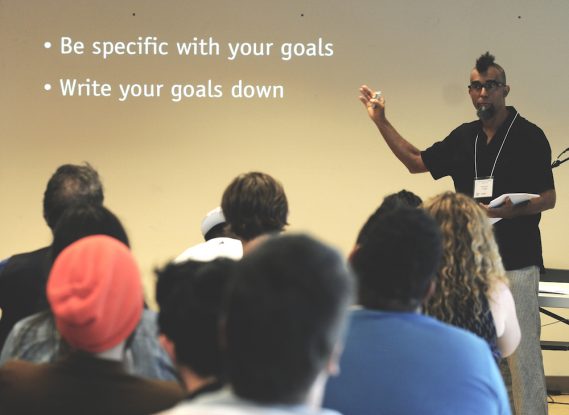Build Your Crew: Developing Core Supporters for Your Work

Artist Dread Scott leading a Creative Capital workshop.
The following post is adapted from artist Dread Scott’s upcoming webinar, Creating a Marketing Strategy, which covers all aspects of marketing your work, including defining your goals, developing effective communication tactics, and building your support community. Below are Dread’s tips for getting your crew of supporters together.
Like everything you do as an artist and a person, your marketing strategy should start with stating your goals. What are you trying to achieve with your efforts? The answers to this question could be “cultivate a funder,” “build an online community,” “sell more tickets,” or “announce a project.” While the objectives vary as much as the creative process, the key is to match your tactics with your goals.
For instance, if your objective is to cultivate a funder, it may not make a lot of sense to devote most of your marketing efforts to social media. Your time would probably be better spent researching the foundation or individual donor you have in mind. It sounds intuitive, but it’s easy to delve into a project first, and then think about the big picture later. Starting with your goals can help ensure you are using your time efficiently.
When developing a strategy to reach audiences, remember: it’s all about relationships. For the introverts out there, no need to immediately descend into a state of panic; you don’t have to capture everybody. For those you do want to reach, you can employ concrete strategies to engage these individuals.
Start by identifying who you want to target. Again, this list will be informed by your individual goals. If your goal is to “build an online community,” perhaps you start with the people who have already engaged with your digital marketing efforts by following your social media accounts. The more specific you can make the target audience, the better. Specificity will help you with the next step, which is developing concrete actions to engage them.

This is where the diagram above becomes helpful: each circle represents an individual’s degree of exposure to your work. As the circle moves inward, people become more connected. The unexposed represent those who are completely unfamiliar with your work. The exposed are familiar with your work, but perhaps only on a surface level. “Connected” individuals are those that are familiar with you and your art, read your book, have exhibited your work, visited your studio, etc. Finally, “core supporters” represent your biggest advocates—people who take every opportunity to support your career. (In her excellent book The Artist’s Guide, visual artist and Creative Capital workshop leader Jackie Battenfield discusses this concept more in depth.)
Try plotting individuals you want to engage with on the diagram. Keep in mind that it’s easier to develop existing relationships than to start new ones. No need to reinvent the wheel; you likely have a group of individuals that already support your work, even if this includes friends and family. Most people probably will fall under the “unexposed” category—and that’s okay. Rather than worry about all the people who haven’t heard of you, try identifying a few specific people you would like to convert from the “unexposed” to the “exposed” group.
Next, you can set up a plan to move individuals inwards. This should ideally be a list of concrete steps or actions you can take. For example, rather than vying to “maintain a dialogue” with a curator, try committing to mailing a personal post-card for an upcoming exhibition three weeks before the opening. Here are a few more examples of how to move people along the categories:
Unexposed to Exposed: Send someone who is unfamiliar with your work a well-written press listing about your upcoming art event. Your efforts will be most effective if you can take the time to do a little research, and match the event announcement to the individual’s interests.
Exposed to Connected: Mail a show card to a critic on your mailing list. Perhaps you decide to throw in couple comp tickets as well. The critic may not only decide to come, but also bring her colleagues as well. Here you’ve not only transferred the invitee from exposed to connected, but also two of her friends from unexposed to exposed.
Connected to Core Supporter: A conversation at an opening with an attendee leads to the purchase of your work. Other people can do this on your behalf as well. In this instance, perhaps a conversation with your dealer incites a new patron.
In summary, 1) Start with your goals, 2) Identify specific individuals you would like to reach, plotting them on the diagram according to engagement, and 3) Develop concrete actions you can take to connect with them.
For more about engaging with your target audience, Join us for Creating a Marketing Strategy on Thursday, July 1st, 7:00-8:30pm to discuss how you can integrate marketing skills into your creative practice.
